Syrian Reconstruction Ready for Takeoff
by Ulf Sandmark, EIR Stockholm correspondent
September 2017
View full size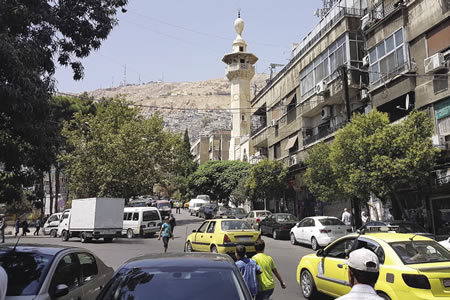
Central Damascus is a beautiful and busy city. |
View full size
The support for the International Trade Fair from the Syrian people was massive, with 300,000 visitors a day. |
September 4, 2017 —The incredible momentum of the Syrian Armed Forces in reconquering vast regions of Syrian territory from ISIS and other terrorist groups, is energizing the Syrian economic recovery. With only four months’ lead time, the Syrian government organized the reopening of the Damascus International Trade Fair to kick off the restarting of the economy. EIR took part in this historic event through its Stockholm correspondent, Ulf Sandmark, who visited the fair as part of a 25- person delegation of Swedish businessmen.
This was the 59th Damascus International Trade Fair since its inception in 1954, after a five year-hiatus during the war. It turned out to be a huge success, with exhibitors from 45 nations and overwhelming popular support, flooding the fair grounds with 300,000 visitors a day. The Syrian people were eager to see the full scope of Syria’s productive powers—the famous Syrian food and textile industries, as well as the chemical and engineering industries. There were also two pavillions relaunching the Syrian heritage of artisans and handicraft. On display were the industries that had been kept going throughout the war, in many cases on a 24-hour basis, joined by restarted industries like the Khallouf Trading Company, which in February 2017 resumed its Hama car manufacturing plant in partnership with the Chinese Dongfeng Motor Company.
View full size
The Political and Media Advisor of the President of Syria, Bouthaina Shaaban (center), with the Schiller Institute’s Talal Moualla (left) and the author. |
View full size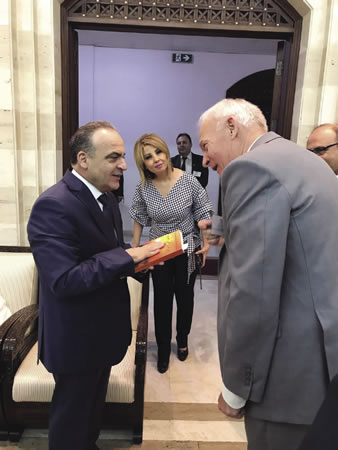
Syrian Prime Minister Imad Khamis receives the EIR special report in Arabic, The New Silk Road Becomes the World Landbridge. |
EIR met with the highest Syrian government representatives, bringing them the full scope of Lyndon LaRouche’s Four Laws policy (here in Arabic) in the form of the Arabic translation by Hussein Askary, of EIR’s World Landbridge Special Report. EIR took part in a meeting at the Prime Minister’s office, where representatives of many of the nations of the old Silk Road renewed their commitment to cooperation with Syria
—a truly historical moment. Syrian Prime Minister Imad Khamis, with a big smile, received his own copy of the EIR Special Report. Sandmark subsequently met with the Minister of Tourism Eng. Besher Yazji, with the Director General of the Syrian Investment Agency, Dr. Inas al-Omawi, and other high officials. A special donation, by a very prominent Swedish EIR subscriber, of 15 copies of the World Land-Bridge Special Report in Arabic for the universities in Damascus and Aleppo, was delivered to the President of Damascus University, Prof. Dr. M. Hassan al-Kurdi. In total, 40 copies were brought to Syria.
The Special Report, with its added chapter, “Phoenix Project Syria: Discussion Points on the Reconstruction of Syria,” will provide crucial input for Syrian economic policy making. See the video about the Phoenix project in the context of the reconstruction of Aleppo. It has also been covered on this Syrian site.
The challenges for Syria are enormous after the devastation of more than six years of war. The World bank has estimated that the war destruction in Syria amounts to U.S. $320 billion. The rebuilding of Syria will definitely require a credit system, taking into consideration that millions of Syrians, especially in youth brigades, need to be put to work in the coming year to maintain the momentum needed to unify the nation and keep peace. A government effort in a New Deal style will be crucial.
View full size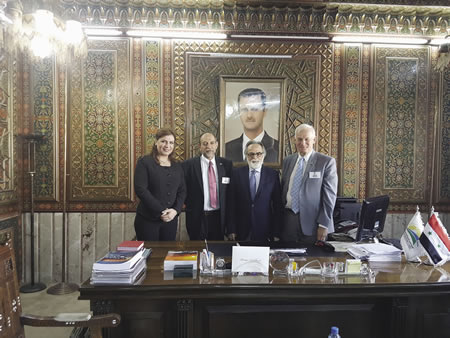 Dr. Inas al-Omawi (left), Director General of the Syrian Investment Agency (SIA) for foreign investors, with the author (right), Syrian representative of the Schiller Institute Mr. Talal Moualla, and delegation member Aly El Khosht. SIA is part of the Office of the Prime Minister and is located in the beautiful, old-style building where the prime minister formerly resided. |
View full size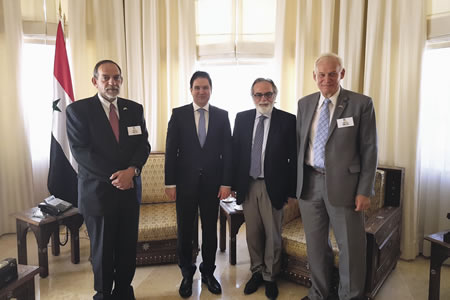 Syria Tourism Minister Eng. Besher Yazji (second from left) received the author (right), Syrian representative of the Schiller Institute Mr. Talal Moualla, and delegation member Aly El Khosht (far left). |
The Friends of Syria has already begun projects to restart the economy. Russia, beside all diplomatic, military and civilian aid, has restarted the coastal railway line and is aiding in the restarting of the petroleum industry. Iran is committed to bring industries, like the one they restarted in 2015 for the production of the Syrian car Sham. China will help rebuild all airports, then the railway system, and subsequently the highway system.
However, the main effort rests on the shoulders of the Syrian nation, which under the leadership of President Dr. Bashar Assad, has conducted the war in the spirit of nationbuilding. The sovereignty of Syria has been asserted with continuous efforts to keep strong national institutions functioning for public services in all sectors. Reconstruction has been ongoing in huge public work projects, during the war. Territories under government control during the war have been repaired and are fully functioning, including the construction of entirely new Damascus suburbs.
View full size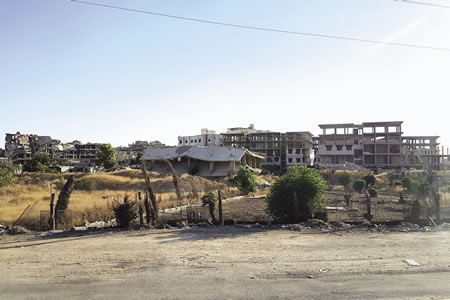 Every destroyed apartment house that could be seen in the Damascus war zones, formerly occupied by gunmen, was under repair. |
The reconstruction of the devastated areas, that used to be occupied by the terrorists, is now fully underway. Every damaged house we saw when travelling in the Damascus suburbs, was under repair, with new walls going up. This is the secret behind the success of the Syrian Arab Army. It is not only because of the support of the military allies, but because of a nationbuilding effort working for victory, with the Syrian population working non-stop to keep their nation functioning: the baker making bread, and health workers, teachers, and school kids doing their part to keep the nation going. The salary for such a public servant is now about U.S. $50-60 per month.
No greater testimony to the broad popular support of the President can be given than this continuing mobilization of an absolute majority of the Syrian people, including the millions of internal refugees who fled into government-controlled areas. It can also be seen in the accelerating national reconciliation process, which is bringing back thousands of former armed rebels to resettle and resume their citizen status, taking up their work in society and sometimes also in the army, to fight their former military allies. At least 600,000 refugees, mainly from Aleppo, have returned to their homes to rebuild.
A Deadly Attack Against the International Trade Fair
View full size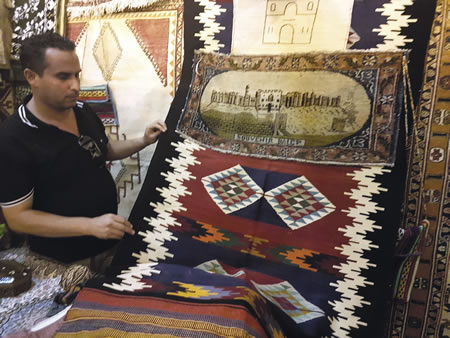 The high-quality Syrian handicraft sector is relaunched as a policy. Here an artisan shows handmade rugs from Aleppo. |
This war mobilization—of the people, by the people and for the people—is the only way to explain the absolutely remarkable reaction by visitors to the Trade Fair to the deadly attack against its entrance. This attack is significant, and it was the only news in most of the Western world media about the remarkable Damascus International Trade Fair.
View full size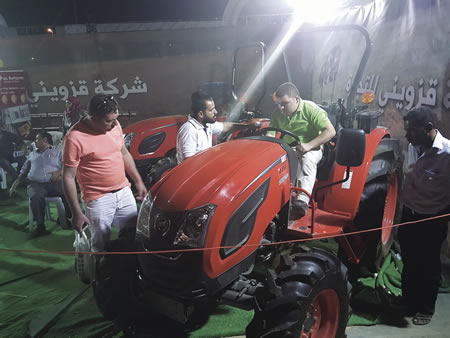 The BRICS nations and Asia were massively present. The South Korean Kioti tractors at the Damascus Trade Fair are shown here. |
View full size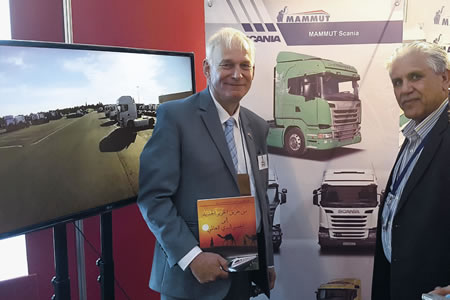 Scania Trucks and Buses was represented at the Damascus International Trade Fair through Iran. Here, the author (left) with Nidal Hana, head of the Hanagroup, which owns the Scania manufacturer in Iran. |
The terrorists from a nearby terrorist-controlled suburb, on the fourth day of the Trade Fair, launched a grenade from a grenade launcher, hitting the side of the entrance building of the Fair Grounds. Nine people died and many were wounded when the the grenade hit the stone pavement and spread deadly shrapnel. Among the the dead were a female export manager and her husband. Later this author inspected the traces of shrapnel on the building and the broken windows.
However, when the Swedish delegation arrived a few hours after the attack, the entrance was crowded with people. The Trade Fair was not shutdown or evacuated. This is the fighting spirit of the population, who continued to come to the Fair Grounds by the hundreds of thousands every day. People wanted to celebrate and take part in the economic recovery of their nation, and would not allow terrorists stop them. They trusted the army to hit back and no further attack was launched against the fair. The whole fair grounds was furthermore under an anti-missile protection shield covering the nearby airport.
The terrorists had broken a deconfliction agreement with the Russians. It is the so-called “moderate” terrorists who have made such agreements, not the other Al-Qaeda-linked group in the occupied Eastern Ghouta Damascus suburb. These “moderates” are the terrorists providing the territorial basis for Mohammad Alloush, of the Jaish al-Islam faction, who is a member of the High Negotiations Committee (HNC), which is leading the opposition delegation in the UN-led peace negotiations in Geneva, as well as in the negotiations in Astana. He has been supported by the Western world, including Sweden, in his role as negotiator for the Syrian “opposition.”
View full size The Damascus 59th International Trade Fair became a people’s festival celebrating the Syrian revival. |
Throughout the war, most of Damascus has been a war zone, where terrorists, from time to time, randomly send grenades from their area, Jobar, just outside the Old City, and from Eastern Ghouta a little further away. The population takes its losses and fights back, working and supporting the army to protect them. The repair work is being done much faster than in Europe. In a visit by this author in 2015, passing by a street crossing attacked the day before, all traces were cleaned up. The wrecked cars had been towed off. Only some new asphalt, and damage to trees nearby, revealed the attack the day before.
This time, on Sunday, Aug. 30, this author heard two grenades hit central Damascus at two different occasions and places. When hearing these grenade explosions, the Syrian people in the streets just shook their heads silently and kept on with their business. Three nights in a row at midnight, the Syrian army, for twenty minutes, fired a special new type of missile that can reach the terrorist tunnels in Eastern Ghouta; even then, the people in the street did not blink an eye.
The Use of Terrorism for ‘Diplomacy’
The terrorists cling to these remaining territories in the Damascus area, hiding in huge tunnel systems for months. They have no military significance at all beyond the capacity to launch terrorist attacks. The occupation of this slice of territory in the Syrian capital is pure cabinet warfare, used for diplomatic purposes, to try to continue the UN negotiations in Geneva, which were intended to bring down Syrian President Dr. Bashar al-Assad and bring chaos as in Libya. These terrorists have helped Western intelligence services stage incidents for international consumption, trying to bring the United States into an open war against the Syrian (and Russian) governments. The most famous was the gas attack in Eastern Ghouta in 2013, where the videos from the incident displayed dead bodies of children, but these were children kidnapped much earlier from an entirely different part of Syria.
The terrorists have brought nothing but destruction, and they oppress the local population in terrorist-held areas, putting women and children in metal cages, on the roofs of buildings as human shields, to prevent their bases and offices from being attacked. They know the Syrian government would not attack women. These hold-outs will soon come to an end. The Syrian Arab Army has been making steady progress in reconquering these suburbs, which are the last Damascus area suburbs remaining in terrorist hands after the recent victory by the combined forces of the Lebanese Army, Hezbollah, and the Syrian Arab Army on the Lebanese border in Qalamoun district. All other areas have been cleared by military campaigns in combination with reconciliation negotiations, where terrorists agreed either to be bussed away to friends in other Syrian areas, or to give up their weapons and settle accounts, and the question of their citizenship, with the Syrian state.
The military campaigns and the genial reconciliation process is about to outflank the UN-led Geneva peace talks. This entirely domestic peace process soon will have settled the conflict, so there will be no more reconciliation to talk about in Geneva. However, after a final military victory, the most difficult part of the domestic peace process will have to proceed for a long time. As Minister of Reconciliation Ali Heidary said: “It is only when the mother of the martyr is reconciled with the mother of the murderer, that the country will come to peace.”
The Need for a Credit System
View full size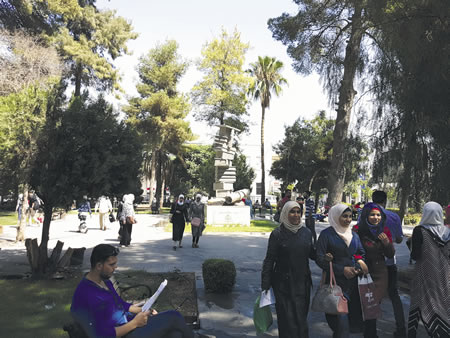 The more than one-hundred-year-old Damascus university is one of the typical, strong backbone institutions of Syria, with 200,000 day students and 70,000 in the evening. It has been open throughout the war in spite of grenade attacks. In the campus park, a monument commemorates the martyred teachers and students. |
The government will have something like a year after the war to bring the people together and take care of its most vulnerable citizens. In that one-year period, millions of Syrians will have to be put to work. Economic development will have to reach all areas, especially areas where there has been dissent. Otherwise Syria will explode again.
Even though the guns of the rebels will have been turned in to the government, the nation will still be full of hidden arms and experienced fighters. Before the war, the economic conditionalities of the International Monetary Fund created austerity for the Syrian population and an economic crisis, which fueled the protests in the heavily orchestrated Arab Spring in Syria.
The British imperial powers and their international coalition will not take a military victory by the Syrian nation and its heroic President easily. EIR emphasized in all discussions with Syrian officials that what the British empire could not achieve by military means, with the help of their terrorists, they will try to accomplish with the help of their banks. They will try to rob the Syrian people of their economic sovereignty, create a new economic crisis, fuel dissent and restart the troubles. With their control of international banks and the financial system, they will try to continue the economic embargo aiming to freeze the nation economically, as they did with the victorious nation of Bosnia Herzegovina in former Yugoslavia which, within the Dayton agreement, was not allowed to control its own Central Bank. That action had blocked its economic development until the recent Chinese action to start huge development programs there.
The difference is just that. Unlike Bosnia and Herzegovina, Syria has been asserting its sovereignty and has friends, like the BRICS countries, as well as among its regional neighbors. However, all financing for reconstruction cannot come from abroad or from rich Syrians in exile. The government absolutely needs a credit system to control the credit flows of the banks to be able to put Syrian industrialists, businessmen, farmers, artisans, and new entrepreneurs, deprived of all resources in the war, back in business. The same goes for putting millions of returning refugees to work, to be able to make a living and rebuild their lives. Likewise for putting young people into work training programs in youth brigades, to integrate the nation in a huge reconstruction effort, as Franklin D. Roosevelt did with the New Deal and the Civil Conservation Corps for youth.
The crucial input of the Four Laws of Lyndon LaRouche in the context of the New Silk Road/World Land-Bridge will therefore be decisive in keeping up the momentum of victory and the full realization of Syrian sovereignty. Syria is now in a full “war mobilization” with its nation-building measures. This puts Syria in the best position to launch a credit system and a New Deal policy to take care of all of its desperately poor—but hopeful—people, people now coming out of the newly liberated but devastated war regions formerly occupied by terrorists.

